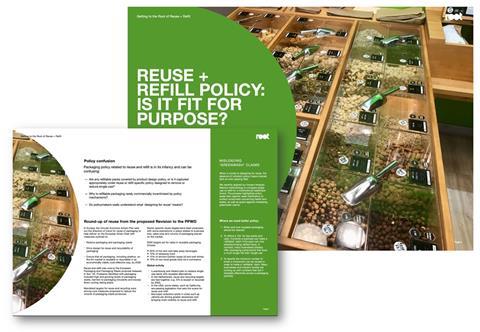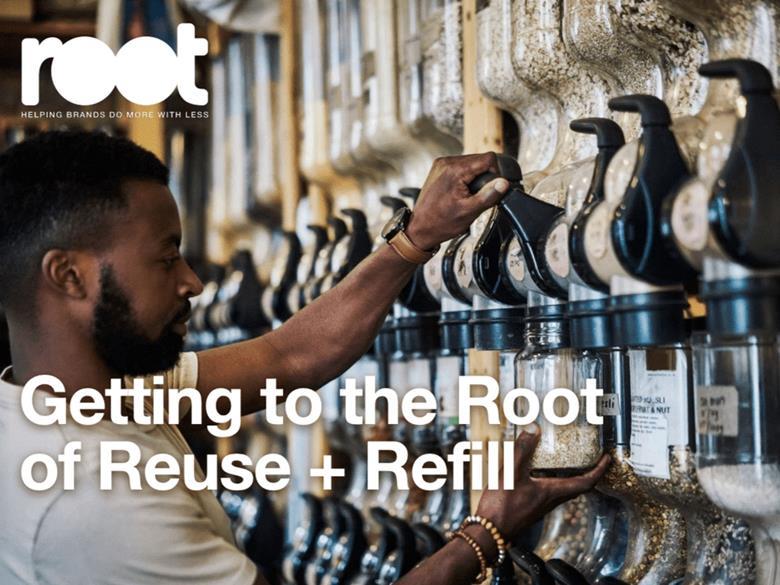A new report from Root reveals the top 5 challenges brands face when implementing a reuse and refill strategy and provides guidance on how to navigate them in this edition of the Spotlight.
‘Reuse and refill’ is a laudable aim – an environmental nirvana whereby customers make repeat in-store purchases using a single re-useable container. Less waste, less carbon, great customer experience, lower compliance fees, a better planet, and reassured shareholders – everyone’s a winner. Right?
Unfortunately not. The reality is that reuse and refill is still very much in its infancy. Any brands stepping into the arena right now will find themselves at the forefront of pioneering change in how consumers shop. Although brands have been discussing reuse and refill for some time, the simple fact is that whilst the ambition might be there, brands cannot do it alone. The practicalities of reuse and refill require the willingness and collaboration of global policymakers, manufacturers, supply chain partners, retailers, and, of course, customers to all play their part in making it happen.
At Root, we’ve worked with brands and producers looking to make the required changes to their business model. And for many brands, a successful transition involves completely reengineering their business and packaging strategy. It’s not something to be entered into lightly, and there will be challenges along the way.
Challenge 1: Lack of guidelines could result in more unsubstantiated ‘greenwashing’ claims
Policy guidelines are still in development and lack the detail needed to enable brands to develop a long-term reuse and refill strategy. The European Packaging and Packaging Waste Proposal has proposed new targets for specific industries. Still, with varying global definitions of ‘reuse’, i.e. the minimum times packaging can be refilled and when and how it should be cleaned, there are no clear and consistent guidelines for brands to follow. This could result in different brands, sectors, and markets interpreting the rules as they see fit, potentially leading to misleading ‘greenwash’ claims and operational chaos.

Challenge 2: Lack of clarity on lifecycle analysis can lead to the wrong action
Industry guidelines about what must be included in a reuse and refill lifecycle analysis are sparse. As a result, brands and retailers are coming up with their own methodologies to prove the worth of their programmes, and many are missing essential elements that could ultimately completely change the results. For instance, refillable packs need to be washed using water, heat, and chemicals. But many LCA studies completely leave this out of their analysis, instead focusing solely on select metrics, like the volume of material and carbon use.
Challenge 3: Reuse and refill is not just a bolt-on; it could require a fundamental change to your business model
Successfully transitioning to a reuse and refill model is not something that can be done half-heartedly. It requires commitment, a dedicated team, significant investment, and the right mindset across the entire business. Many brands have tried and failed, often because they haven’t put the right level of resources into making it happen, and even those that have, haven’t found it easy. It’s not just a case of bolting it on as a ‘nice to have’ – it needs to be placed at the centre of your product and packaging strategy.

Challenge 4: Consumers will accept or reject reuse and refill based on how easy it is for them to engage
For many brands that have trialled reuse and refill programmes, consumer buy-in was the final hurdle that tripped them up. Consumers will only engage with a reuse and refill programme if it’s simple and easy to use. Most consumers are keen to do the right thing, often choosing brands that fit their personal ethos and values, such as the desire for a more sustainable planet. But if the consumer experience is not entirely frictionless, previous trials have shown that many consumers revert back to buying ‘single use’, simply because reuse and refill was too complicated, expensive, or required too much effort.
Challenge 5: Brands need to collaborate and learn – even with their competitors
It’s not easy to be open and honest about the challenges you encounter, especially when your customers and competitors are watching. But reuse and refill is new territory for everyone, and the fastest route to success is to share experiences and best practice to avoid making the same costly mistakes. There are plenty of people and businesses out there already sharing their experiences and collaborating with each other. Through their willingness to have open and frank discussions in the public arena, together we can ensure reuse and refill becomes a reality that everyone can benefit from.

Download the free report – ‘Getting to the Root of Reuse + Refill’
Root’s team of packaging and sustainability experts has compiled a new report, ‘Getting to the Root of Reuse + Refill’, that takes a closer look at each of these challenges, with links to valuable frameworks, reports, and case studies from organisations, retailers and brands currently pioneering the reuse and refill concept.
To download the free report ‘Getting to the Root of Reuse + Refill’ go to https://root-innovation.com/getting-to-the-root-of-reuse-and-refill-report/.
Source:
https://packagingeurope.com/why-brands-are-failing-at-reuse-and-refill







